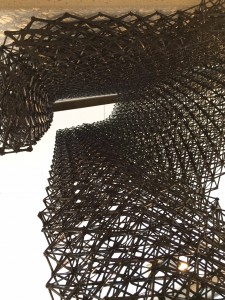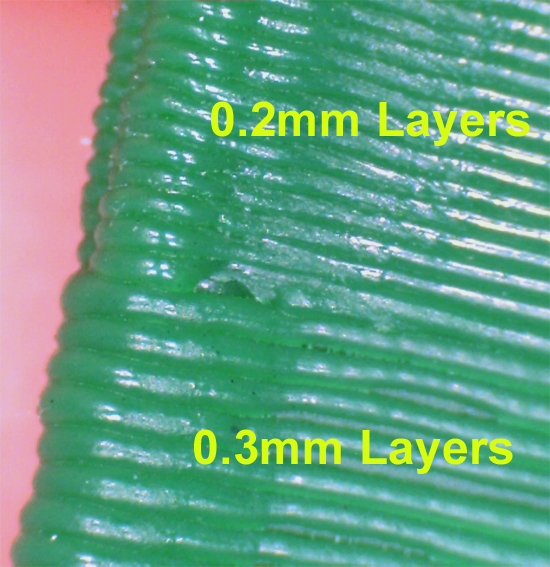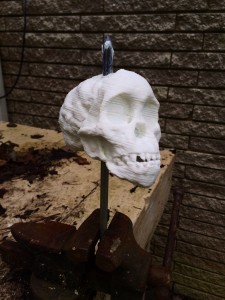3D Printing Exhibit at MoDA is a must see
Since the EDGE magazine project is still in the planning stages, I thought I’d start out this semester by talking about an exhibition I saw recently that I highly recommend.

In Designers, Makers, Users: 3D Printing the Future, The Museum of Design Atlanta is presenting an educational examination of the past, present, and future of 3D printing. The importance of 3D printing can’t be overstated, and the exhibition offers up a great overview of the technology and what it can do, but as a panel of informative text so eloquently states, “the dream of the Star Trek Replicator may not be immediately at hand.”

3D printing technology and definitions can get highly complex, but as a general primer for the uninitiated, 3D printing is a form of additive manufacturing that creates forms by stacking and binding layers of material from the ground up until the desired form is reached–as opposed to subtractive manufacturing like CNC routers or laser cutters, which removes raw material to create the intended form. In art terms, you could think of it like layering coils of wet clay to form a ceramic pot (additive), versus carving a marble block (subtractive).
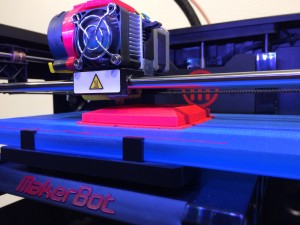
The most common form of 3D printing for the average consumer is called Fused Deposition Modeling (FDM) and is analogous to a computerized hot glue gun. This is the Makerbot you might have heard about, and most of the printers at GSU. A digital 3d model is sliced by software into lots of very small layers, which are then sent as instructions to the printer. Plastic filament in spools of (typically) plant-based PLA or petrol-based ABS (though many new materials are emerging, like brick, wood, metal and even pancake batter), is pushed through a heating element to its melting point, then extruded through a nozzle onto a build platform. The nozzle then moves up slightly, and repeats the process, continuing until the object is complete. A crucial requirement for 3D-printing material is that it cools quickly enough that by the time the nozzle is finished extruding its layer and moves up to the next, it can support the layers above.

MoDA has dedicated two rooms and a hallway to the exhibit, with gobs of informational text and video that showcase examples of 3D printing in several areas, including space exploration, medical, architecture, product design, and fashion. The only art-for-art’s-sake display I saw was a short stop-motion animated film by Gilles-Alexandre Deschaud called, Chase Me, where a monochrome ukulele-playing girl is chased by some malevolent blob of nastiness. Hijinks ensue. The film used what’s called replacement animation, where instead of animating a single articulated puppet bit by bit for each frame, character statues were printed whole for every single frame in whatever pose was needed and swapped out each time a new frame was shot, resulting in probably hundreds of individual character figures (the Jack Skellington character from A Nightmare Before Christmas used a combination of puppet and replacement: his body was articulated but 400 unique heads were created to swap in and out each frame to create his facial animation). Several were on display next to a monitor showing the video, including eight slightly-different versions of the girl lined up in a row. I assume from context that this was intended to show all the parts needed to execute an animated walk cycle, but a couple were out of order and listing dangerously close to falling over. This exemplifies a common occurrence throughout the exhibit, where the rough edges start showing through from wear and tear, tarnishing the polish of the initial presentation. I’m surprised everything’s held up as well as it has considering how many kids have gone through the place.
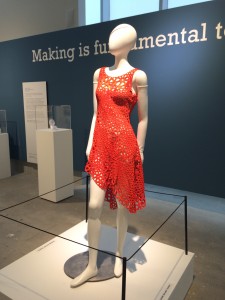
There are numerous examples of 3D-printed objects, from DIY prosthetics to a 3D-printed dress to giant (in 3D printing scale) architectural forms and even a desktop bio-printer. A borg of various brands and kinds of desktop 3D printers were whirring away throughout the exhibit. Some were printing parts for a 3D-printed puzzle-chair, others looked like parts for a prosthetic hand, and others I couldn’t discern at all because they were currently a mess of spaghetti-like strands. An on-site technician was vigorously running around trying to keep up with all the printer failures, and having built and used my own 3D printers, I didn’t envy him his task. This brings us back to our initial concern: though 3D printers are revolutionizing production, they’re not yet appliances. You don’t have to troubleshoot your toaster, or know how sugars caramelize with heat to create toast. You just put in your bread and out comes delicious and tasty toast. Not so with 3D printing.
If toasters were at the technological level of a typical consumer 3D printer, the toast-making process would be much different. First, you’d have to make your own bread. Sure, you could probably find someone who could make the bread for you but if you want true production freedom you need to invest in learning how to make bread in its various forms using specific bread-making tools and techniques–In 3D printing, you can download 3D files that someone else made, but if you want to make your own unique objects, you have to learn 3D CAD software. Next, you have to know how your particular toaster works, and coordinate your toasters heat, time, and spring tension to perfectly match your particular piece of bread’s chemistry. Get something wrong and you have to toss your ruined bread and start over–In 3D printing, each material melts at specific temperatures, and even the dyes used in plastic filament can cause the heat requirement to vary by degrees. Get the temperature wrong and your print is ruined. Then, once you’ve got your bread’s protein chemistry and your toaster’s electronic settings synced up, you’re ready to toast. Insert slice, push lever. But you can’t leave yet. Oh no. You have to sit there and watch the toaster start toasting for at least the first cycle, otherwise the bread could get jammed, or fall out of the toaster entirely, or decompose into its component parts–In 3D printing, the first layer is crucial, if it doesn’t go well, the rest of the print likely won’t either, and you’ll have to start over. Or, sometimes the print gets unstuck from the print bed, and you can’t just put it back on and continue where you left off, you have to start over and toss the ruined print. Now that you’re sure your everything is running smoothly, you can let the toaster toast that yummy bread and go do something else. For 3-20 hours. Or more–it’s called rapid prototyping, but “rapid” is a very relative term. Oh, and at any point during the toasting process, your toaster might screw up your bread, and you have to toss it and start over, but not before troubleshooting and repairing your toaster yourself. Good luck on the forums.
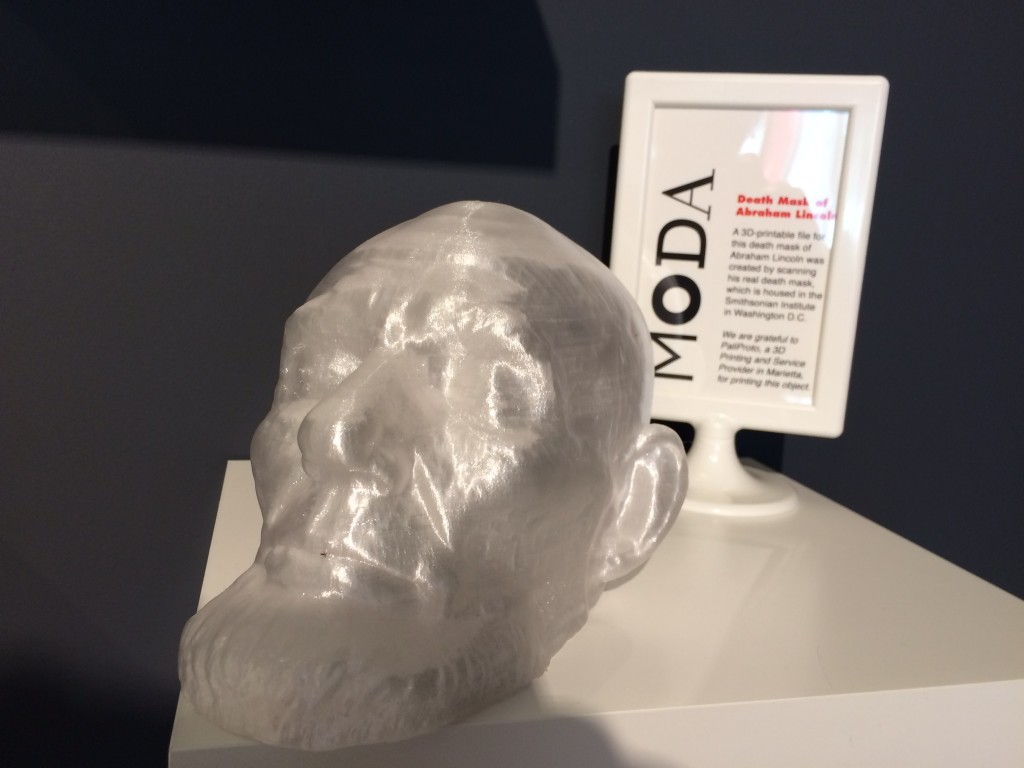
Don’t let me nightmare toaster story deter you from the potential and wonderfulness that is 3D printing. Manufacturers are getting closer and closer to that appliance stage, so it won’t be long before we all have desktop 3D printers in our homes next to our toasters and inkjet printers. MoDA has presented an almost-comprehensive survey of 3D printing; I would have liked to have seen more examples of purely artistic uses of 3D printers, but regardless, Designers, Makers, Users: 3D Printing the Future is a must see for all ages and levels of technical savvy.
